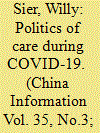| Srl | Item |
| 1 |
ID:
182975


|
|
|
|
|
| Summary/Abstract |
This article employs the concept of care as a lens through which to examine the anti-COVID-19 measures taken in post-lockdown Wuhan. Based on photographs that depict the Chinese response to COVID-19 at the epicentre of the virus outbreak, the article analyses the visibility of anti-virus measures as a form of government communication inscribed textually and symbolically onto the urban landscape. The state demonstrates its care and capability by implementing highly visible high-tech measures to contain the virus. Bringing care into the literature on crisis management in China sheds light on the Chinese state’s reaction to COVID-19 in eliciting nationalist sentiments and positive feelings of cooperation while stigmatizing critical voices as uncooperative and unpatriotic. It shows that care is central not only to the functioning of liberal democracies: the Chinese state also relies on narratives about care to showcase the superiority of its political system and to distinguish between desirable and unwanted forms of citizens’ political engagement after the COVID-19 outbreak.
|
|
|
|
|
|
|
|
|
|
|
|
|
|
|
|
| 2 |
ID:
182439


|
|
|
|
|
| Summary/Abstract |
This article assesses the politics of post-mortem visual representation in media. Studying different representation of death in Turkey and Russia, it explores the intersection of visual images, death, and sovereignty. The existing studies have established that dead bodies are pushed to the private sphere and rendered invisible in media representation. The case studies suggest we should not only focus on the corporeal visibility of the dead body but also on the representation of identity markers, such as the person’s face and associated symbols. On the other hand, some of the bodies are treated as objects; they are rendered invisible as nameless and faceless figures. Building on Agamben, this article suggests that post-mortem representation produces biologically dead subjects whose political lives are worthy of saving, those worth sacrificing, and the bare dead. Therefore, sovereignty resides not only in deciding the value of life but also of the dead.
|
|
|
|
|
|
|
|
|
|
|
|
|
|
|
|